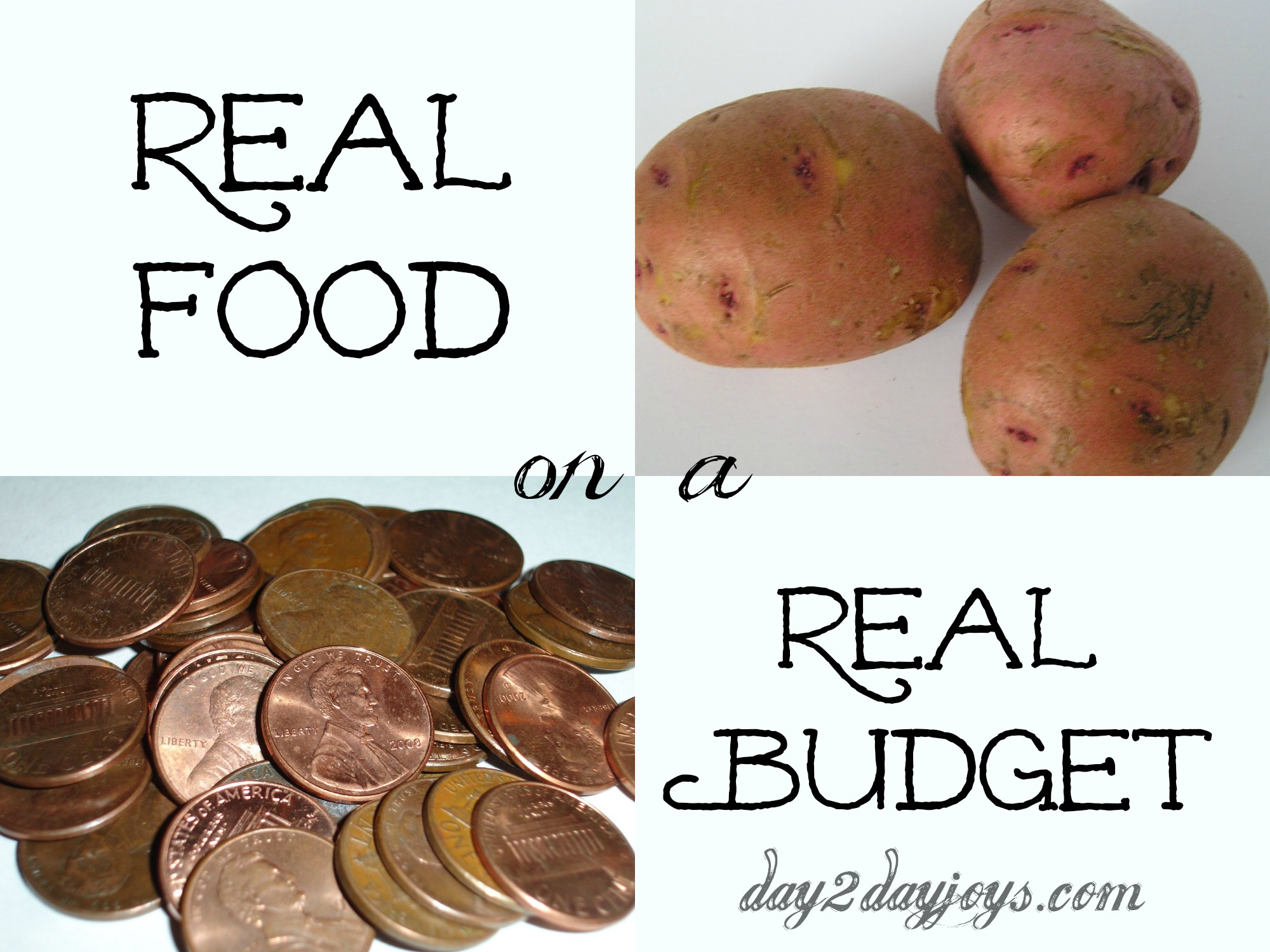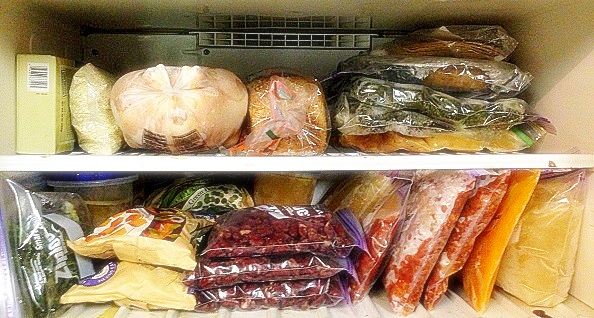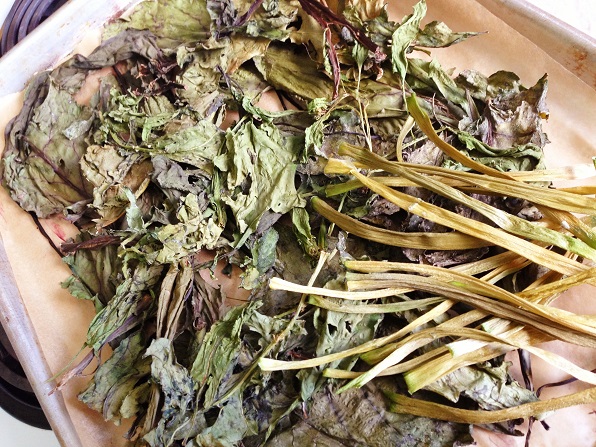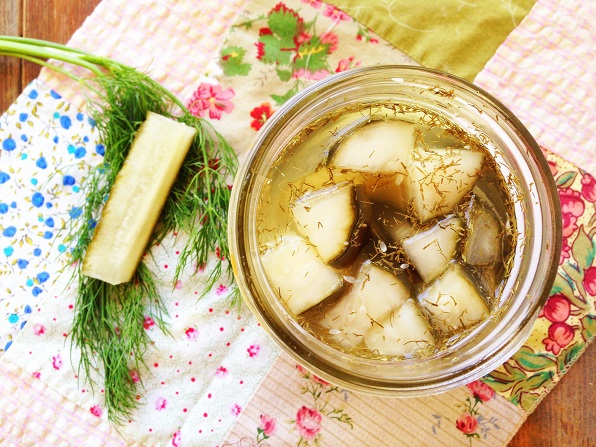The post What It’s Like to Afford Fresh Organic Produce and How You Can Do It Too appeared first on Day2Day Joys.
]]>**Please meet Reelika, a new contributor… she would love to hear from you! -Rachel
You are a great mommy. You want the best for your kids and family. It is the hope of many families to be able to provide organic veggies, fruits and berries to their family and especially to the kids. Unfortunately the downside of organic produce is the cost. But what if I told you there are ways that you can still provide the best organic produce to your kiddos without breaking your budget?
As a mom to an allergic toddler and having been diagnosed with hypothyroidism myself, I have done lots of research about the benefits of organic food. I am not a health care advisor, but I can share what has worked for our family and how you can do it too.

Organic produce has been very beneficial for our family. Since my toddler is allergic to many things, I provide him with several organic veggies, fruits and berries. He loves this delicious organic produce and is not a picky eater anymore. He used to be very hyperactive, but since switching to organic food, we don’t seem to have much of a problem with it anymore.
We cut back on other things, but invest into our health, so it keeps us away from pharmacies, doctor’s office and hospitals. Being healthy means also being more productive and happy at preschool, home and work.
Top 3 Tips on How to Afford Organic Produce
Tip # 1 – Organic Produce as an Investment
Don’t look at the price tag of the organic produce as a number; instead, see it as an investment. Compare it to the costs of medications, health care and doctor’s visits.
Chances are you have heard that non-organic food can contain pesticides and cancer-causing hormones or even GMOs. Research shows that pesticides can cause not only cancer, but also allergies, skin and neurological issues, ADHD, birth defects and much more.
Children are especially sensitive to pesticides due to their development and growth. You can either pay the farmer or the pharmaceutical business.
It is time to invest into your and your family’s health. The truth is, many people don’t think about it until they have some kind of health problem. I have to admit, I am completely guilty as I was one of them.
I never felt the need for organic food, until I was diagnosed with hypothyroidism during pregnancy. Since then I have invested into my health instead of the medications I had to use. In fact, medications were more expensive than my investment in organic produce, and I am so much healthier now.

Tip # 2 – Prioritizing Organic Produce
Take a look at what other monthly expenses you have – a new iPhone, expensive jewelry, eating out several times per week, new fancy toys, etc. If you can afford any of them, you can also afford organic produce. Find ways to cut back on monthly payments and use the money instead for quality organic produce.
I am always looking for ways to cut back on our monthly expenses. Saving water and lowering heating costs increases our grocery budget. A monthly budget gives you a crystal-clear overview of your highest expenses so you can make your own choices of where to cut back.
Tip # 3 – Making the Right Choices
It can save you big bucks if you are making the right choices. Be aware of when and which organic produce to buy.
Here is what to keep in mind while choosing fresh organic produce:
- If you bought expensive organic veggies yesterday, then find less expensive produce to buy next time you do groceries. It keeps your budget in balance.
- Meal plan and create a grocery shopping list. Buy the amount of veggies you are planning to eat so you won’t be wasteful.
- Be creative with organic veggies that are close to expiring. You can use them for smoothies, baking, or soup.
- Buy what is on sale or close to its expiry date. It can save huge bucks when the expiration date is close by. Just make sure you use it as soon as possible.
- Buy local. Any organic local veggie is always cheaper than an imported one.
- Prefer seasonal. Prioritize what is in season as it tends to be cheaper, and you can also freeze these for the non-seasonal time.
- Don’t buy pre-washed and packaged food, as these cost much more.
- Prefer healthy veggies and berries for snacks. Leaving chocolate, cookies and chips out of your grocery list saves you money for organic veggies, fruit and berries.
- Frozen organic veggies are great choices as well. Buy them in bulk and while on sale.
- Grow your own organic herbs that you can use for meals. You don’t need a yard to grow your own green leafs. All you need is a small space in kitchen or on a balcony to have your own organic herb section. I also have mini-tomatoes growing in my kitchen.
- Wash the produce just before using it so it will last longer.
- Citrus produce can last at least a week longer when stored in the fridge.
- Don’t forget coupons! Find the best deals and use them.
- Negotiate if possible. When buying directly from a farmer, use your negotiation skills. Offer to buy in bulk and don’t be afraid to ask for a discount. Most likely the farmer will be more than happy to offer you a discounted price when selling more. You can freeze the extra for later and will have saved big bucks.

Fresh organic veggies, fruits and berries are always going to be expensive, but investing into our family’s health and cutting back on our monthly expenses has made a difference for our well-being. Making the right choices keeps us on budget and provides a quality lifestyle. You can do it too!
Did I miss anything? How do you make organic produce affordable for your family?
The post What It’s Like to Afford Fresh Organic Produce and How You Can Do It Too appeared first on Day2Day Joys.
]]>The post Real Food on a Real Budget appeared first on Day2Day Joys.
]]>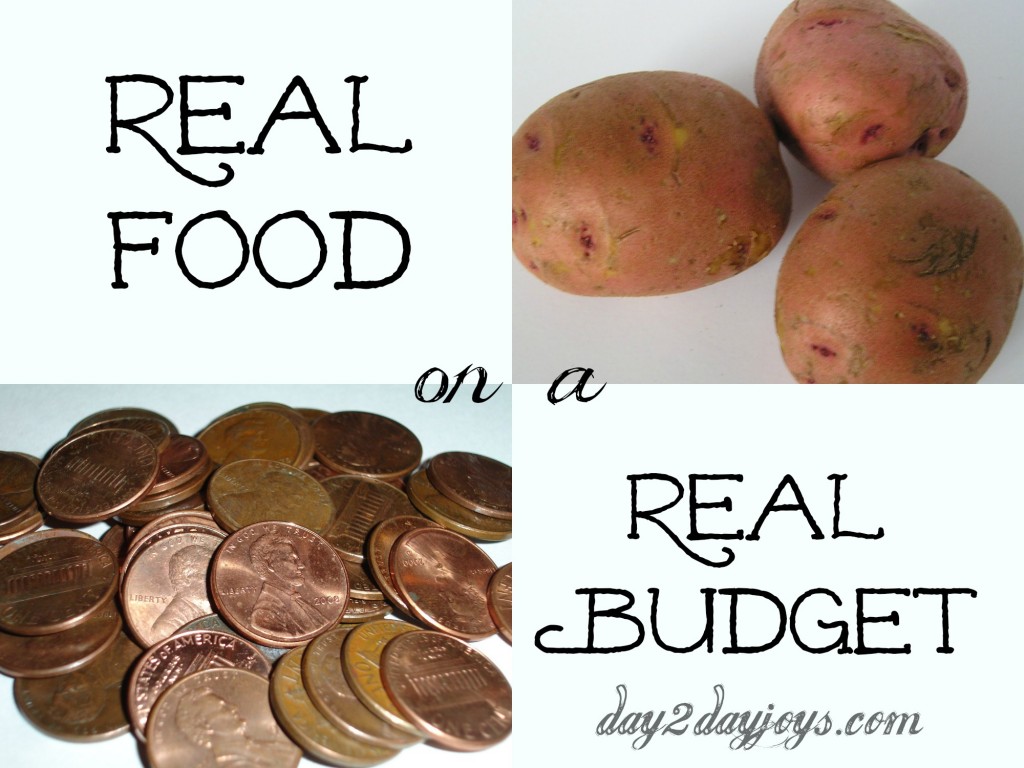
Written by Kristen @ Smithspirations, Contributing Writer
With it being January, you may very well be trying to cut out the processed foods in your diet and take a more whole foods approach to eating. I don’t think anyone denies that eating well is a great way to boost health, but often finances get in the way of making positive changes. Does eating real, whole, healthy foods have to break the bank?
I’m convinced that it doesn’t!
Our family lives on a moderate income. My husband is a public school teacher, and while his salary is far from glamorous, it pays the bills. We have a little bit of supplemental income from a few sources, like my home business, but with our growing family of five children, we have to watch our budget in all areas.
By God’s grace, I’ve found various ways to keep our plates healthy while still keeping our budget in check.
This post contains affiliate links. Purchases made through these links come at no additional cost to you but can bless our family with a small commission. Thank you!
Buy In Bulk
Many foods are suitable for buying in bulk and then storing, drying, canning, or freezing for later.
Berries can be frozen, greens and herbs can be dehydrated, and tomatoes and other fruits can be canned. While the initial cost is a little intimidating, buying a quarter, half, or whole animal for freezer meat is much less expensive per pound, and you can also get more bones for making and freezing broth!
Now that we have a grain mill, I buy our grains for flour in large 25 or 50 pound bags and usually get them for 50 cents to a little over a dollar a pound, depending on the type.
Shop Your Backyard
Gardening can be intimidating, but as long as you approach it with some grace, it can be a wonderful way to cut back on your grocery bill! You’d also be surprised by how many backyard “weeds” are actually very nutritious foods! My children can often be found munching on purslane, sorrel, and chickweed from our yard when we are outside, and I sneak them into salads and cooking, too.
Eat What’s Local
Sometimes it’s easy to get caught up in the latest super foods that have to be purchased from expensive specialty stores. But real food can also be really common food that is easy to find. Check local farmers’ markets during the growing seasons and focus on what is abundant and inexpensive. In the winter time, turn your attention to frugal foods like winter squash, carrots, and the humble potato.
Roll Up Your Sleeves
Packaged and convenience food is always more expensive. A bag of frozen french fries costs more than a bag of potatoes. Doing more of the prep work yourself is a fantastic way to save money even if it does require a little more effort. Enlist your children if they are old enough and share the labor while making fun memories together!
Shop Online
Sometimes one of the best ways to save money is to shop online. Foods that don’t spoil easily, like pastas, rice, and beans can be found online at great discounts! Amazon has a huge grocery selection. For example, I get my organic coffee from Amazon with Subscribe & Save. It ships for free, and I get a discount on the price. Win!
Vitacost is another site I like to check when I’m shopping for foods or household items. (If you’re a first-time customer, you can get $10 off with this link!)
Stretch Meat With Beans and Lentils
Meat is definitely one of the priciest items in our grocery budget, but I believe it is really important to our health! I often make meat stretch a little farther by adding cooked beans or lentils to ground beef and using a whole pound of dried beans with a 3 pound roast to make a bulk batch of taco filling.
Now it’s your turn! What are your best tips to help save money while eating real, healthy food?
The post Real Food on a Real Budget appeared first on Day2Day Joys.
]]>The post Dehydrating Greens for Easy Nutrition All Winter Long appeared first on Day2Day Joys.
]]>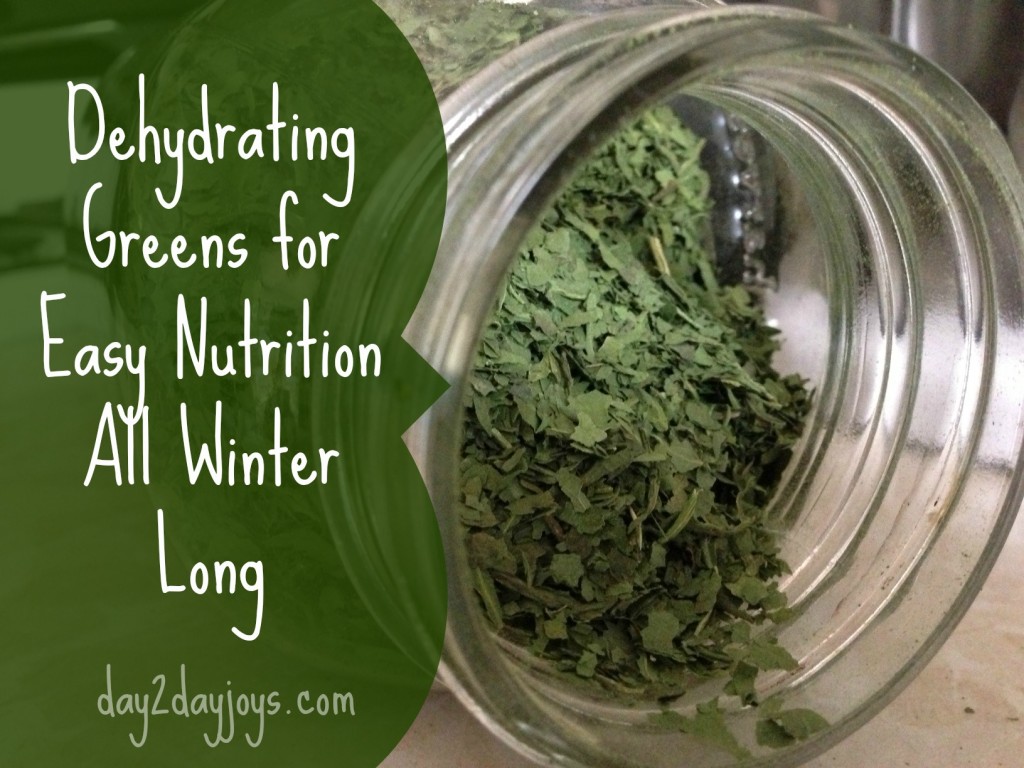
Written by Kristen, Contributing Writer
This has not been the grandest year for my garden. There’s no abundance of tomatoes to can, no peppers to freeze, and hardly enough basil to make one batch of pesto, but I decided to give myself grace with gardening and not aim for perfection. I’ve realized that even in an off-year with the garden, certain crops always do well.
One of those for us is Swiss chard, and I’ve got more than our family cares to eat. In the past I would lightly steam and freeze it to use in place of frozen spinach in recipes, but it rarely would get completely used up, and I’d rather save the freezer space for something else, like blueberries. I still hate to see it just sit in the garden, though!
The Dehydrator to the Rescue!
My husband really blessed me this year with an Excalibur food dehydrator (Amazon affiliate link), and it’s been a lifesaver when it comes to preserving food with little time and effort from me. After doing lots of peaches, herbs, and some tomatoes, it dawned on me that I should dehydrate the chard for the winter!
Dehydrated chard (or other similar greens) can be added to soups, pastas, breads, smoothies, and more. They take up very little room in the pantry and can quickly add a boost of nutrition to any recipe. Leafy greens are famous for their high content of vitamins and minerals, and having them on-the-ready will be a great help to me this winter and early spring!
How to Dehydrate Chard
The steps to dehydrate chard are so easy! These steps leave you with a dried chard that could still be considered raw. Some people feel that chard and other dark leafies should always be eaten cooked to diminish the oxalic acid in them that can act as an anti-nutrient. If you are concerned about oxalic acid or think that you’ll use your dehydrated greens mostly in smoothies, you can lightly steam the leaves before dehydrating them. I don’t think this will be our primary use, so I dehydrated them raw.
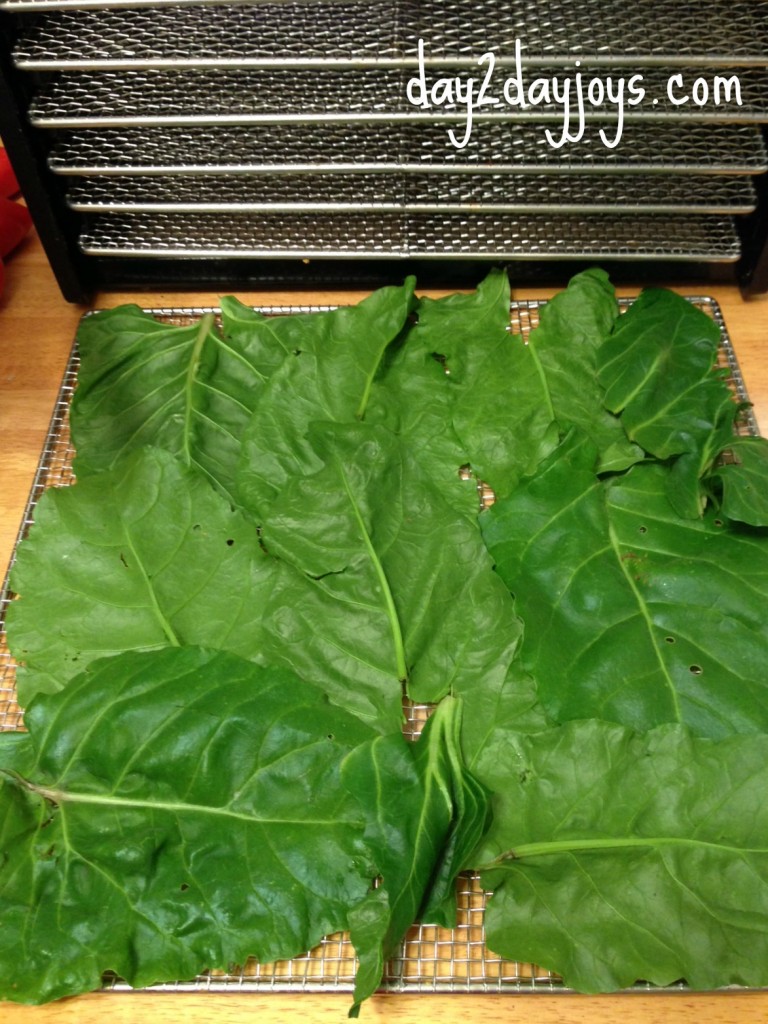
1. Remove the thick stems and veins, and wash the leaves so that they are free of grit. Remove any discolored leaves or sections. (If you want to dehydrate the stems, you certainly can. Just slice them into smaller pieces and expect them to take longer than the leaves.)
2. Lay the leaves on the dehydrator tray in a single layer. A little overlapping is fine, but too much will cause them to dry unevenly and too slowly.
3. Fill up all of the trays, or lay out all of the leaves that you have, and dehydrate the leaves according to your machine’s directions. In my dehydrator, the chard leaves take longer than green herbs, but less time than juicy fruits or vegetables.
4. Once the leaves are completely dry, place them in a food processor. Pulse it to crumble the leaves uniformly.
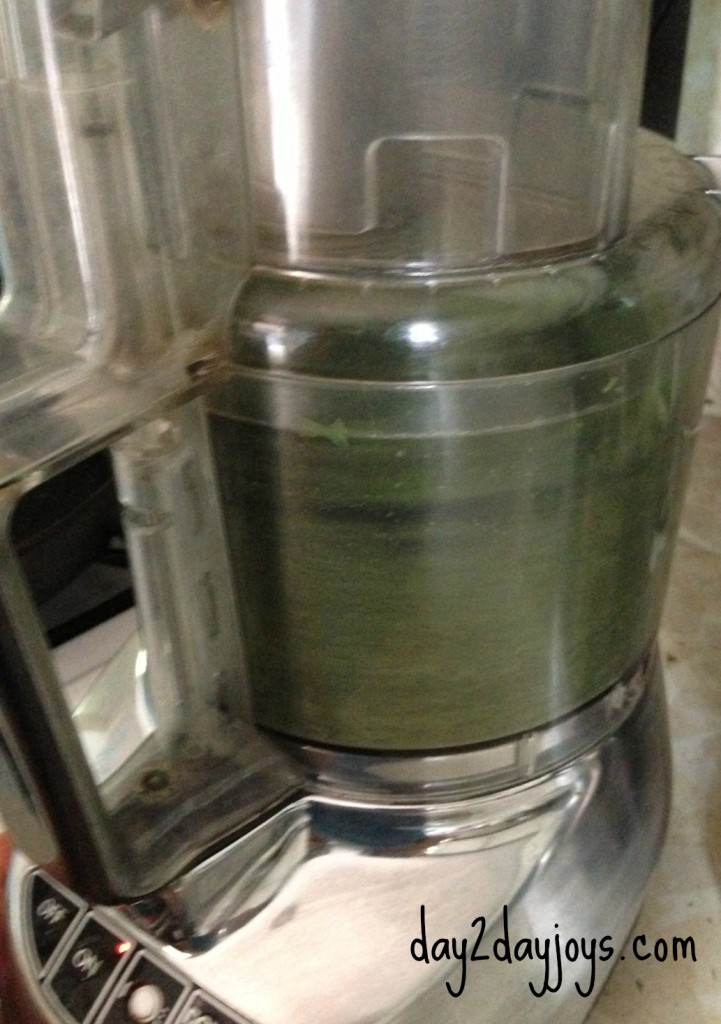
5. Store the dried and crumbled leaves in an airtight container. I prefer glass jars, but plastic freezer bags work as well.
Ta-da! You can now enjoy chard all through the cold winter and early spring months.
It’s amazing how one giant grocery bag filled with chard can be dehydrated down to a quart-sized jar of dried chard! I’m imagining soups, baked pastas, and green tortillas all made with our dried chard.
Have you ever dehydrated greens before, or do you like to freeze them? Is there another veggie that you like to dehydrate for easy food storage? Do share!
*this post is linked to: Encourage One Another, Titus 2sdays, and WFMW*
The post Dehydrating Greens for Easy Nutrition All Winter Long appeared first on Day2Day Joys.
]]>The post 3 Simple Methods to Save Money and Stop Wasting Food appeared first on Day2Day Joys.
]]>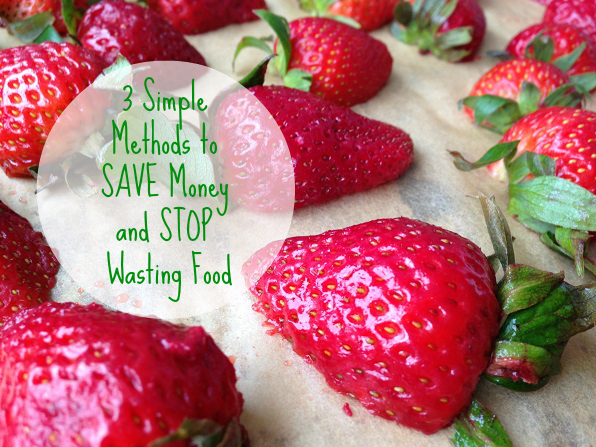
Written by Kari, Contributing Writer
Do you cringe when it comes to wasting food? I certainly do and it seems that in our society it’s not looked down upon like it used to be. There was a time when the only food a family had was what they grew on their land. Maybe small towns had a quaint little corner store that sold some food items – but they weren’t like our Walmart Supercenters or Krogers.
People valued food and I think we’ve lost that in this day and age of abundance, prepackaged foods and laboratory made foods available on every corner in America (think Doritos, Little Debbies, Captain Crunch and Slurpees).
So how can we be good stewards of the provision we have been given when it comes to food? What steps can we take to make our food supply last longer? Even if you don’t have a harvest from a garden, you can take these simple methods and use them when you are buying food from the farmers market or grocery store.
The three simple ways I save money and stop food waste in our home are:
1. Freezing
2. Deyhdrating or Drying
3. Fermenting
Now before you stop reading this thinking this is only for homesteaders – know that this is for everyone! I don’t live on land, own cattle or have a farm. I live in the suburbs with an 8’x12′ garden, a summer farmer’s market up the street and a wonderful health food store near us where they only sell organic produce, YET I employ all these sources in keeping my shelves stocked with amazing food year round.
Let’s take a look at each of these individually…
FREEZING
Whether you are harvesting a great yield from your garden or seasonal fruit and vegetables are priced great at the store, take this opportunity to freeze portions of these for use later in the season. Buy more than you’ll need, then freeze the rest. This is also great to do with vegetables, homemade sauces, beans and meat.
Buying meat when prices are good and freezing it (freezing times vary with type of meat) can save some money down the road when prices raise due to seasonal/weather changes or unexpected issues, like drought. Doing a quick search on the internet on instructions for freezing specific foods will provide many resources and instructions on how to successfully achieve this wonderful preservation method.
– To freeze fruit, wash and allow them to dry thoroughly. Lay them out in a single layer on a lined baking sheet. Stick this in the freezer until they are frozen, then transfer to a freezer bag or container. – To freeze veggies, it’s more of a process and you’ll need to blanch and chill them before freezing. – Blend up smoothies or juice fruits and veggies, then freeze them in ice cube trays, then transfer them to freezer bags or containers to use in smoothies at a later time. – Pre-make sauces, soups, stock and beans and freeze to use in the cooler months. – Keep all your veggie scraps when making other dishes, freeze them and use them to make vegetable stock. – Save bones from whole fryer chickens to make bone broth.
The possibilities are endless! Just make sure you have a good system in your freezer to store all these items. I find that freezing in freezer bags and laying them flat offers up the most space saving option.
DEHYDRATING OR DRYING
This method is great for all your greens, herbs, some veggies and even fruit. When you only need 2 tablespoons of fresh cilantro, you still have to buy it as a ‘bunch’, so you’re left with extra. Instead of letting it go bad, throwing it out or even composting it (although, once it’s gone bad – this is the best option) – dry or dehydrate the leftovers for your own dried herbs.
Oftentimes I hang my herbs to dry in a cool dark place, then grind them down and store in a glass container. When you buy or grow items like kale, chard, lettuce, spinach, etc., these are great to dehydrate and to process them into a green powder (including stems and leaves). Add these to soups or make your own green powder blend to drink – you’ll get amazing nutritional benefits from these concentrated powders.
If you don’t have a dehydrator, this can easily be done in the oven or even out in the summer sun. When using an oven, choose the lowest setting (150 on older models, 170 on newer) and heat with door shut for 2 hours. At that time, open the oven door slightly for ventilation and allow to continue heating until items are thoroughly dried. During the summer, this is best done in the evening hours so you don’t heat up the house.
Other foods you can dehydrate are nuts and seeds, which allows for an extended shelf life along with making them healthier and easier to digest. Favorites in my house are homemade trail mix, dehydrated cinnamon apple slices and sweet potato chips with sea salt. I’ve also made raw cookies using a dehydrator and they were amazing!
FERMENTING
This is such a wonderful preservation method that has been used for centuries and truly offers amazingly healthy foods! We typically think of pickles and sauerkraut, but you can ferment foods such as eggs, cabbage, beets, watermelon, dairy and meat.
There are many wonderful websites out there that will walk you through fermenting foods and they offer delicious recipes. It’s a process of creating an environment for a chemical breakdown and change in food (typically lactic-acid and alcohol fermentation).
A couple favorites at our house are my Summer Sun Pickles, Homemade Cream Cheese, DIY Crème Fraiche and Homemade Yogurt and Dairy Kefir. Make sure you don’t get sidetracked by all those articles that say fermented foods are harmful. This method to preserve food has been around since the beginning of time and research shows that those cultures who used this method (and those that still use this method) are some of the healthiest people on the earth. Refrigerators and stoves are relatively new.
Microwaves are babies in the age of kitchen appliances – so we have to realize that cultures had to prepare and preserve food in ways that didn’t require modern technology. These methods proved to be nutritionally beneficial and insured there was no waste to their provision. Remember they didn’t have Walmart down the street to go stock up on food! I love gleaning from past generation’s wisdom when it comes to food since they were a whole lot healthier then we are in 2013!
These are just three simple and easy methods that will save you money on your grocery bill and keep your pantry, freezer and refrigerator full during fresh food’s off-season! It will feel amazing to be a good steward of your money and food and not to mention that you’ll be feeding your family nutrient dense foods for optimum health!
What is your favorite way to preserve and extend the life of your abundance of food?
The post 3 Simple Methods to Save Money and Stop Wasting Food appeared first on Day2Day Joys.
]]>The post Saving Money in Your Budget by Using More Cloth & Less Paper appeared first on Day2Day Joys.
]]>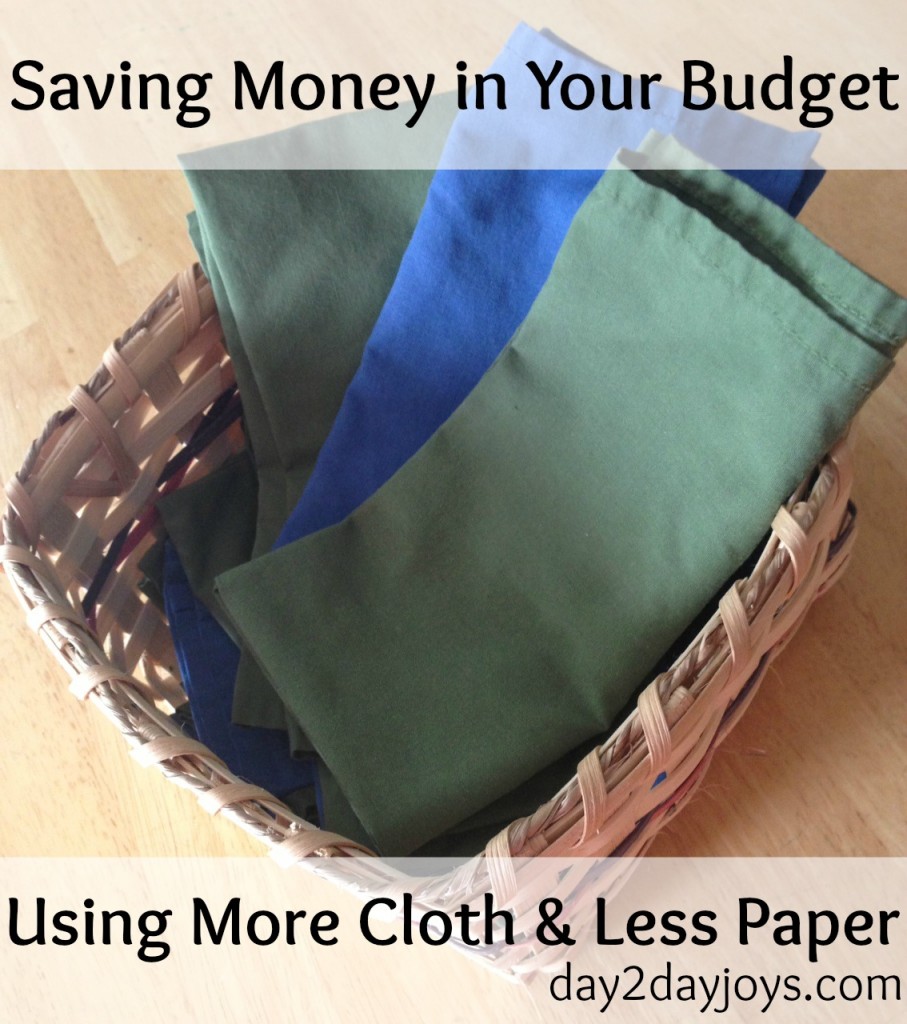
Written by Kristen, Contributing Writer
I don’t know of a single family, and especially those with young children, that isn’t looking to save money in one way or another. Sticking with a family budget isn’t always easy, especially with a growing crew of little ones! One area that is continually a challenge is the grocery bill. We have to eat, and we want to eat well for the sake of our health, but the cost of a whole foods diet can sometimes hurt.
Rather than cutting out important healthy foods, have you ever thought about cutting out some of the disposable paper products you buy on your trips to the grocery store to make your budget more manageable? It can save you a surprising amount of money without really creating a lot of extra work! Let me share some ideas.
Switching from Paper to Cloth
This section contains an affiliate link. Purchasing through the link comes at no additional cost to you and may give the author a small commission. Thanks!

Most of us, when we hear about switching to cloth, will inevitably think of diapers, especially if we have a little one in them! But there are so many other places in our home where cloth can easily be used and washed instead of something else that is used and then thrown away. For instance, have you ever thought about using:
- Cloth napkins? We switched to cloth napkins a couple of years ago after it finally dawned on me that it was silly to continually throw paper ones away. We just bought inexpensive ones from a big box store and usually throw them in with the laundry at the end of the day. You can also use washcloths as cloth napkins, turn inexpensive flat sheets into beautiful stenciled napkins, and make cloth napkins a meaningful family tradition.
- Cloth cleaning rags? Paper towels quickly add up, especially when you use them to clean in the kitchen and bathroom. I’ve found that cotton rags and cleaning cloths work just as well as any paper towel! Old cotton t-shirts, hole-y or mismatched cotton socks, and worn out cloth diapers make great cleaning cloths, and they are free!
- Cloth diapers and baby wipes? For years I was totally intimidated by the idea of cloth diapering until a friend told me how much it had changed since my mom’s generation and how many user-friendly options there are today. Now I can’t believe it took me so long to give up disposables! Cloth diapers and cloth wipes are so simple to use and so economical. It’s estimated that a family can save $2,000 or more per diapered child just by using cloth! Check out Confessions of a Cloth Diaper Convert (affiliate link) if you are still on the fence. It’s a super resource!
- Cloth “tissues”? I always remember my dad and grandfathers carrying around a “hankie” (usually a folded up red or blue bandana) in their back pockets to use as a tissue during the day. While we still mainly stick with boxes of paper tissues in our house, I’ve definitely seen cloth alternatives at work!
- Cloth feminine pads? This is another option that I haven’t tried myself yet, but plan to after our baby is born. Disposable pads are often made with all sorts of bleaching chemicals, and I don’t like to think of those next to my most delicate skin. Cloth pads save money in the end and avoid the toxins, too. Read what Paula of Whole Intentions has to say about the benefits of cloth pads.
- Family cloth? Here’s one that simply won’t happen in most households, and truly, that’s okay! Family cloth is a polite way of describing the cloth alternative to toilet paper. Our family hasn’t gone that route, and I doubt we ever will, but my blogging friend Anjanette wrote a very convincing case for it!
How Much Will You Save?
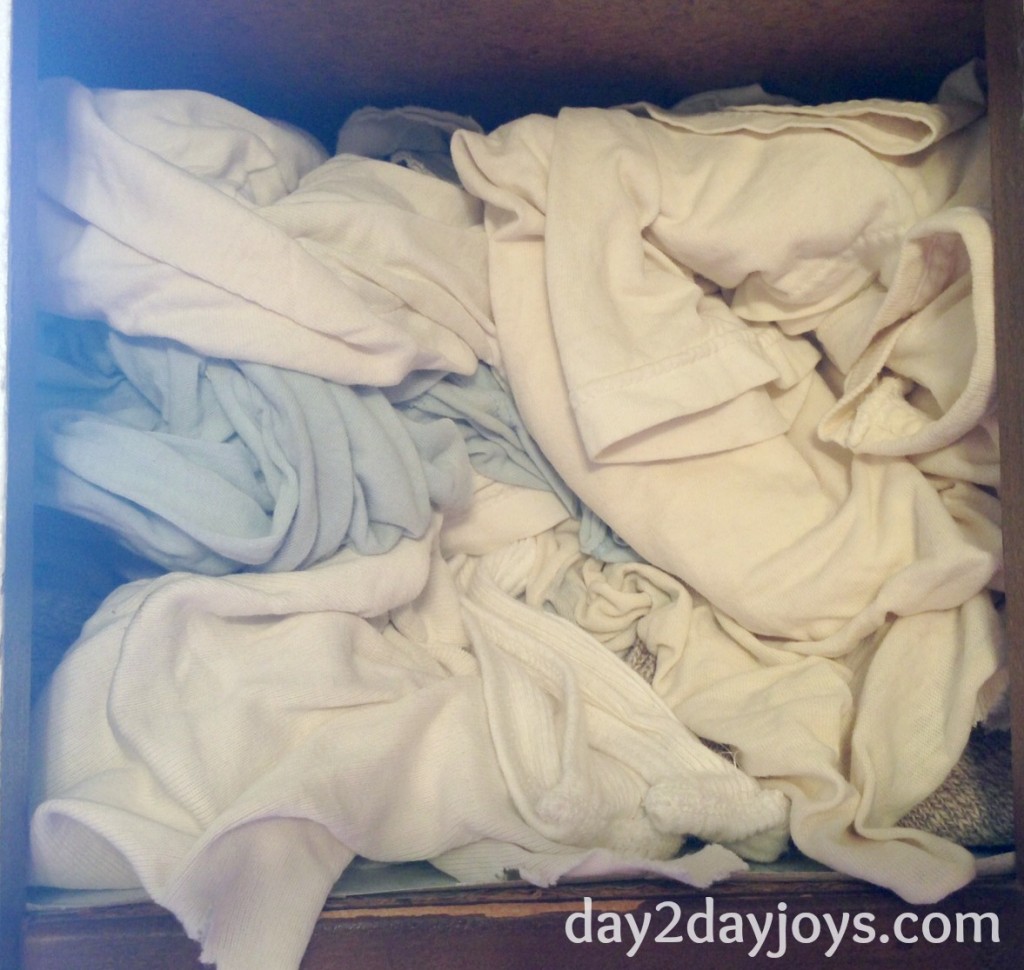
The exact amount saved from your budget will obviously depend on lots of factors. How extensively you use your paper products, how large your family is, and general lifestyle habits will all play into the savings. For our family, we’ve saved a tremendous amount of money by not buying disposable diapers for the last four years. With another baby on the way (our third in cloth), the savings continue to add! I can’t remember the last time I bought paper towels, and the only time we buy paper napkins or plates is when we are hosting a birthday party or recovering from a new baby addition. The savings have been very real to us!
But that’s not all. Our small town recently updated how they handle trash pick-up, and my husband and I discovered that we can pay by the bag. Since we use so little disposable products and practice composting and recycling extensively, we were able to drop our trash bill from $20-$25 per month down to about $3-5 per month!
But Is the Extra Work Worth It?
That’s a legitimate question. Frugality can be taken to such an extreme that the blessings of convenience are ignored. For our family, we’ve found that using cloth in place of most disposable paper products adds an additional two to three loads of laundry a week, with most of that being diapers. Cloth napkins and cleaning rags don’t even make up a load themselves! Our children are in charge of folding most of the laundry, and these cloth items are usually the job of our four-year-old. Preschoolers can easily handle folding cloth napkins and diapers, and our daughter usually gets a great deal of satisfaction from completing this job by herself.
Of course there are times when it makes sense to just use some disposable items: parties, welcoming a new baby, periods of family sickness, or times of over-commitment. But for the most part, I’ve found cloth alternatives to many paper products to be a fantastic way for our family to save money without working too hard!
Do you use some of these cloth alternatives to paper products in your family? How has is worked for you? Or is the thought of less paper and more laundry totally overwhelming? I’d love to hear your thoughts!
The post Saving Money in Your Budget by Using More Cloth & Less Paper appeared first on Day2Day Joys.
]]>
